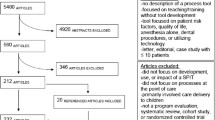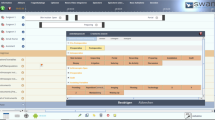Abstract
Purpose
According to differences in patient characteristics, surgical performance, or used surgical technological resources, surgical interventions have high variability. No methods for the generation and comparison of statistical ‘mean’ surgical procedures are available. The convenience of these models is to provide increased evidence for clinical, technical, and administrative decision-making.
Methods
Based on several measurements of patient individual surgical treatments, we present a method of how to calculate a statistical ‘mean’ intervention model, called generic Surgical Process Model (gSPM), from a number of interventions. In a proof-of-concept study, we show how statistical ‘mean’ procedure courses can be computed and how differences between several of these models can be quantified. Patient individual surgical treatments of 102 cataract interventions from eye surgery were allocated to an ambulatory or inpatient sample, and the gSPMs for each of the samples were computed. Both treatment strategies are exemplary compared for the interventional phase Capsulorhexis.
Results
Statistical differences between the gSPMs of ambulatory and inpatient procedures of performance times for surgical activities and activity sequences were identified. Furthermore, the work flow that corresponds to the general recommended clinical treatment was recovered out of the individual Surgical Process Models.
Conclusion
The computation of gSPMs is a new approach in medical engineering and medical informatics. It supports increased evidence, e.g. for the application of alternative surgical strategies, investments for surgical technology, optimization protocols, or surgical education. Furthermore, this may be applicable in more technical research fields, as well, such as the development of surgical workflow management systems for the operating room of the future.
Similar content being viewed by others
References
Neumuth T, Jannin P, Strauss G, Meixensberger J, Burgert O (2009) Validation of knowledge acquisition for surgical process models. J Am Med Inform Assoc 16(1): 72–80
Jannin P, Raimbault M, Morandi X, Riffaud L, Gibaud B (2003) Model of surgical procedures for multimodal image-guided neurosurgery. Comput Aided Surg 8(2): 98–106
Jannin P, Morandi X (2007) Surgical models for computer-assisted neurosurgery. Neuroimage 37(3): 783–791
Ahmadi S, Sielhorst T, Stauder R, Horn M, Feussner H, Navab N (2006) Recovery of surgical workflow without explicit models. Med Image Comput Comput Assist Interv 9(1): 420–428
James A, Vieira D, Lo B, Darzi A, Yang GZ (2007) Eye-gaze driven surgical workflow segmentation. Med Image Comput Comput Assist Interv 10(2): 110–117
Münchenberg JE, Brief J, Raczkowsky J, Wörn H, Hassfeld S, Mühling J (2001) Operation planning of robot supported surgical Interventions. In: Proceedings of IEEE/RSJ international conference on intelligent robots and systems. IEEE Computer Society, pp 547–552
Mehta NY, Haluck RS, Frecker MI, Snyder AJ (2002) Sequence and task analysis of instrument use in common laparoscopic procedures. Surg Endosc 16(2): 280–285
Casaletto JA, Rajaratnam V (2004) Surgical process re-engineering: carpal tunnel decompression—a model. Hand Surg 9(1): 19–27
Malik R, White PS, Macewen CJ (2003) Using human reliability analysis to detect surgical error in endoscopic DCR surgery. Clin Otolaryngol Allied Sci 28(5): 456–460
den Boer KT, Straatsburg IH, Schellinger AV, de Wit LT, Dankelman J, Gouma DJ (1999) Quantitative analysis of the functionality and efficiency of three surgical dissection techniques: a time-motion analysis. J Laparoendosc Adv Surg Tech A 9(5): 389–395
Strauss G, Fischer M, Meixensberger J, Falk V, Trantakis C, Winkler D et al (2006) Workflow analysis to assess the efficiency of intraoperative technology using the example of functional endoscopic sinus surgery. HNO 54(7): 528–535
MacKenzie CL, Ibbotson A, Cao CGL, Lomax A (2001) Hierarchical decomposition of laparoscopic surgery: a human factors approach to investigating the operating room environment 10(3):121–128
Meng F, D’Avolio LW, Chen AA, Taira RK, Kangarloo H (2005) Generating models of surgical procedures using UMLS concepts and multiple sequence alignment. AMIA Annu Symp Proc 520–524
Blum T, Padoy N, Feußner H, Navab N (2008) Workflow mining for visualization and analysis of surgeries. Int J Comput Assist Radiol Surg 3(5): 379–386
Westbrook JI, Ampt A (2009) Design, application and testing of the Work Observation Method by Activity Timing (WOMBAT) to measure clinicians’ patterns of work and communication. Int J Med Inform 78(Suppl 1): 25–33
Cook JE, Wolf AL (1995) Automating process discovery through event-data analysis. In: ICSE’95: Proceedings of the 17th international conference on software engineering, New York, pp 73–82
Agrawal R, Gunopulos D, Leymann F (1998) Mining process models from workflow logs. In: Ramos I, Alonso G, Schek H, Saltor F (eds) Advances in database technology—EDBT’98, pp 469–483
Schimm G (2004) Mining exact models of concurrent workflows 53(3):265-281
de Medeiros AKA, Weijters AJMM, van der Aalst WMP (2005) Genetic process mining: a basic approach and its challenges. In: Workshop on Business Process Intelligence (BPI), Nancy
Aalst WMP, Dongena BFV, Herbst J, Marustera L, Schimm G, Weijters AJMM (2003) Workflow mining: a survey of issues and approaches 47(2):237–267
AWMF (2008) Leitlinien für Diagnostik und Therapie. (German clinical guidelines) [Internet]. Arbeitsgemeinschaft der Wissenschaftlichen Medizinischen Fachgesellschaften e. V. Available from: http://www.awmf-leitlinien.de/
AHRQ (2008) Agency for Health Care Research and Quality: National Guideline Clearinghouse [Internet]. Available from: http://www.guideline.gov
Neumuth T, Durstewitz N, Fischer M, Strauss G, Dietz A, Meixensberger J et al (2006) Structured recording of intraoperative surgical workflows. In: Horii SC, Ratib OM (eds) SPIE medical imaging 2006—PACS and imaging informatics: progress in biomedical optics and imaging. Bellingham, WA CID 61450A
Cleary K, Kinsella A, Mun SK (2005) OR2020 Workshop report: operating room of the future. In: Lemke HU, Inamura K, Doi K, Vannier MW, Farman AG (eds) Proceedings of the 19th Computer Assisted Radiology and Surgery CARS, pp 832–838
Archer T, Macario A (2006) The drive for operating room efficiency will increase quality of patient care. Curr Opin Anaesthesiol 19(2): 171–176
Schuster M, Wicha LL, Fiege M, Goetz AE (2007) Utilization rates and turnover times as indicators of OR workflow efficiency. Anaesthesist 56(10): 1060–1066
Author information
Authors and Affiliations
Corresponding author
Rights and permissions
About this article
Cite this article
Neumuth, T., Jannin, P., Schlomberg, J. et al. Analysis of surgical intervention populations using generic surgical process models. Int J CARS 6, 59–71 (2011). https://doi.org/10.1007/s11548-010-0475-y
Received:
Accepted:
Published:
Issue Date:
DOI: https://doi.org/10.1007/s11548-010-0475-y




